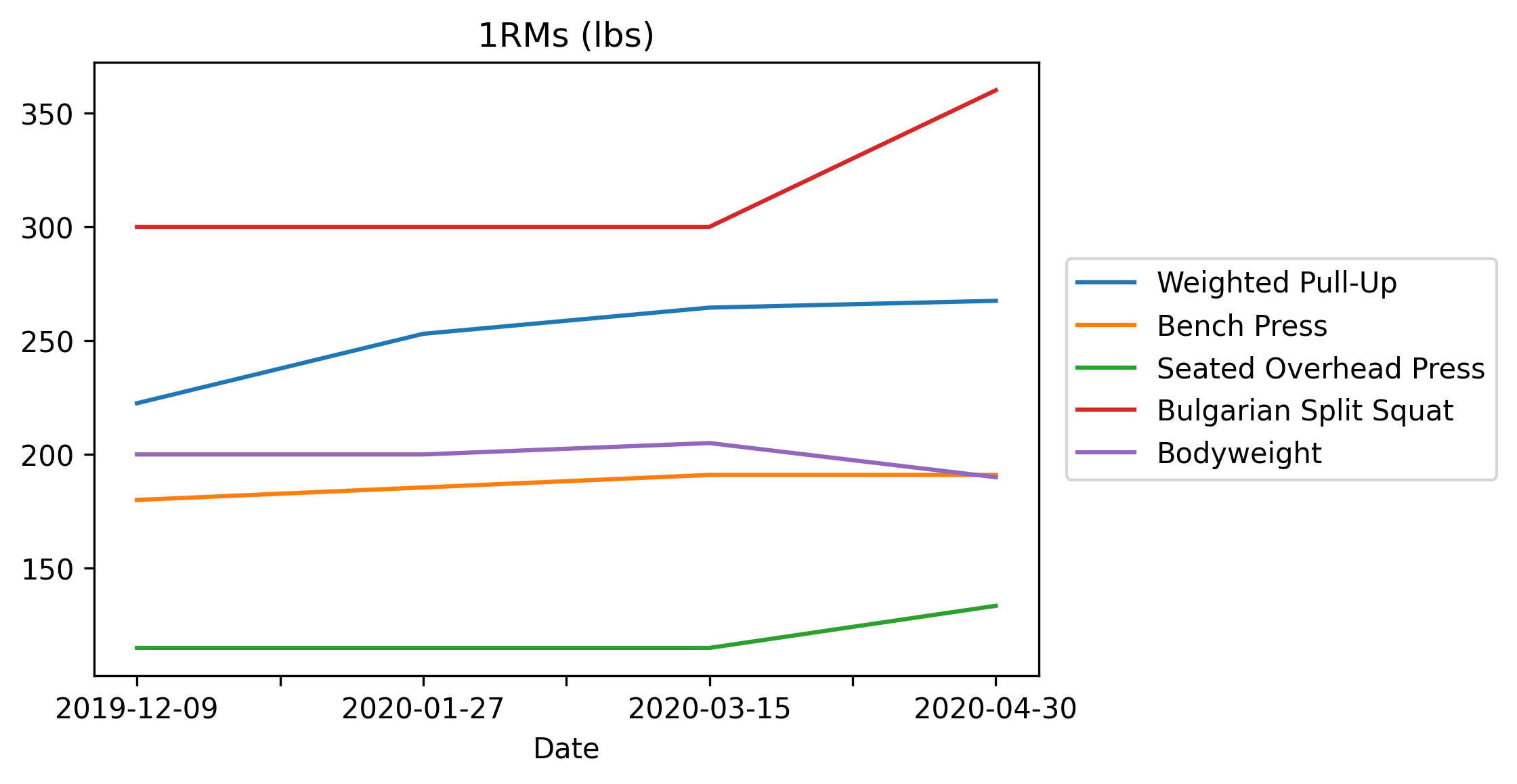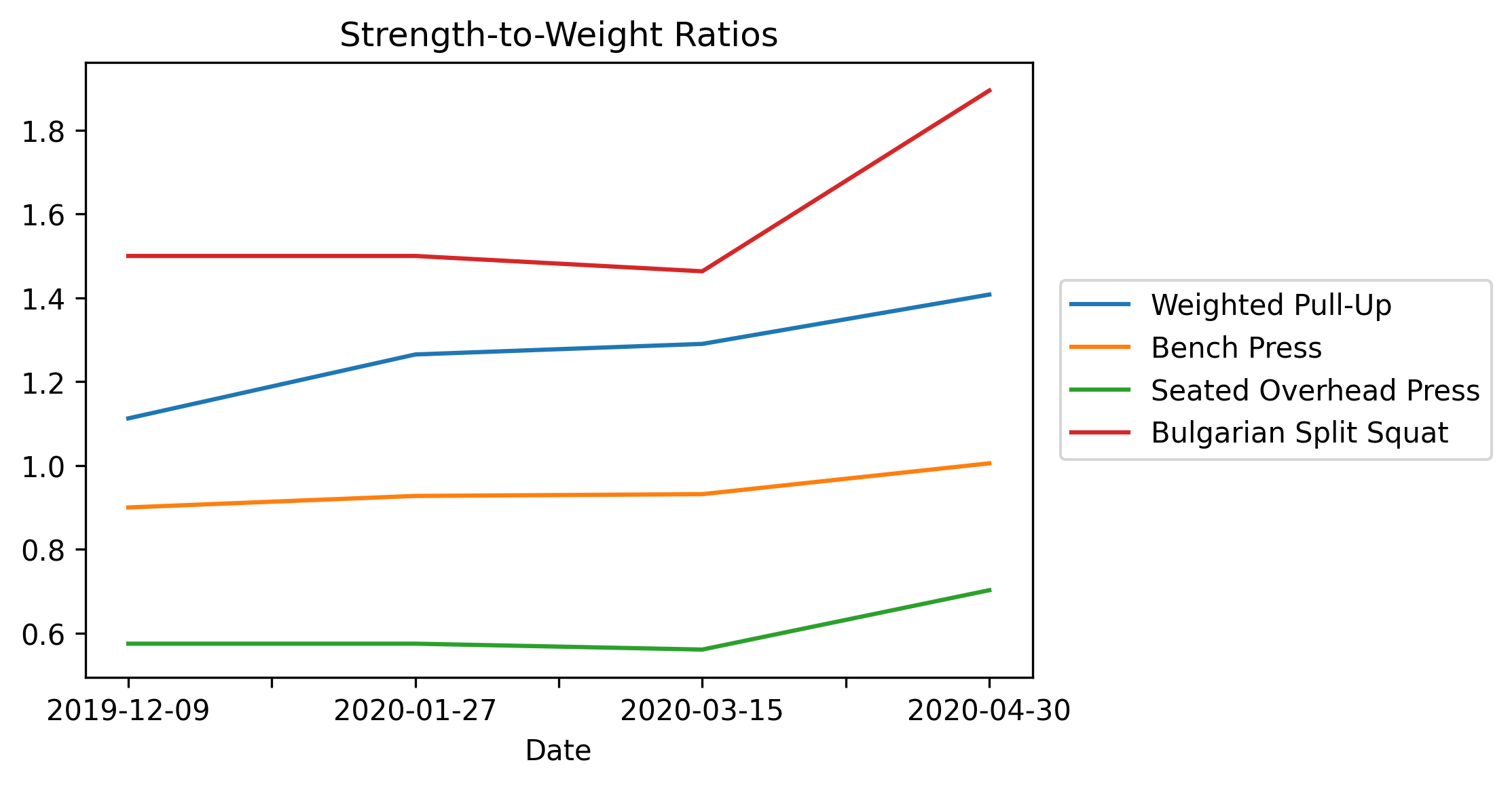Update - 1/04/24
Well, this is a few years out of date. The whole pandemic lasted a lot longer than I think anyone really expected. Especially with the California lockdowns.
I wish I could say that left me with smooth and continuous progress, but it wouldn’t be true. We moved, had a kid, and I encountered a small host of minor, but lengthy, injuries. Along the way, I ended up making some changes to my routine.
For lifting, I switched out of the tactical barbell program (with its focus on 1RM testing), and into a more “bodybuilding” style of lifting. 5 week long phases, with a lot more volume (sets of 10+), and a gradual peaking followed by a recovery week. I started this new routine in mid-December, 2020, and am currently halfway through Phase 19. At 5 nominal weeks / phase, that means I’ve been about 60% efficient with my lifting compared to an ideal schedule.
I’ve also ended up with a better table tennis setup at home. I’ve now got a table, robot, and most importantly, enough room to use it, so drills with that have become a regular part of my routine. I’ll write about my shot accuracy tracking system in a later update.
Overall, my best guess has me in pretty good overall shape. I definitely don’t have the level of conditioning that I did when I was spending 10+ hours a week at the table tennis clubs pre-pandemic, and I definitely don’t have the level of raw, 1RM strength that I did at the peak of that training, but I’m at an acceptable middle on both of those, with a clear improvement in strength-endurance (from the focus on greater volume of reps) as well as body composition.
In the meantime, I’ve got clear directions to go for improvement, and the most important step is the next one.
Update - 10/27/20
Latest graphs at the end of a bulk cycle.
Bench press 1RM stayed the same, but my shoulder injury is almost totally healed, so… win some, lose some?
Not pictured here is my progress with kettlebells which I’ve added as a recurring part of my routine (because really, who computes 1RMs for kettlebell swings?). In any case, I’ve worked my way up to 2-hand swings with a 24kg bell, 1-handed swings with a 20kg bell, and Turkish Get-Ups with a 20kg bell. Unfortunately, I’ll pretty soon be maxed out with the kettlebells that I have (only have up to 24kg), so I’ve started to keep an eye on the usual suspects (Rogue and Vulcan, I’m looking at you!) for their next restock.

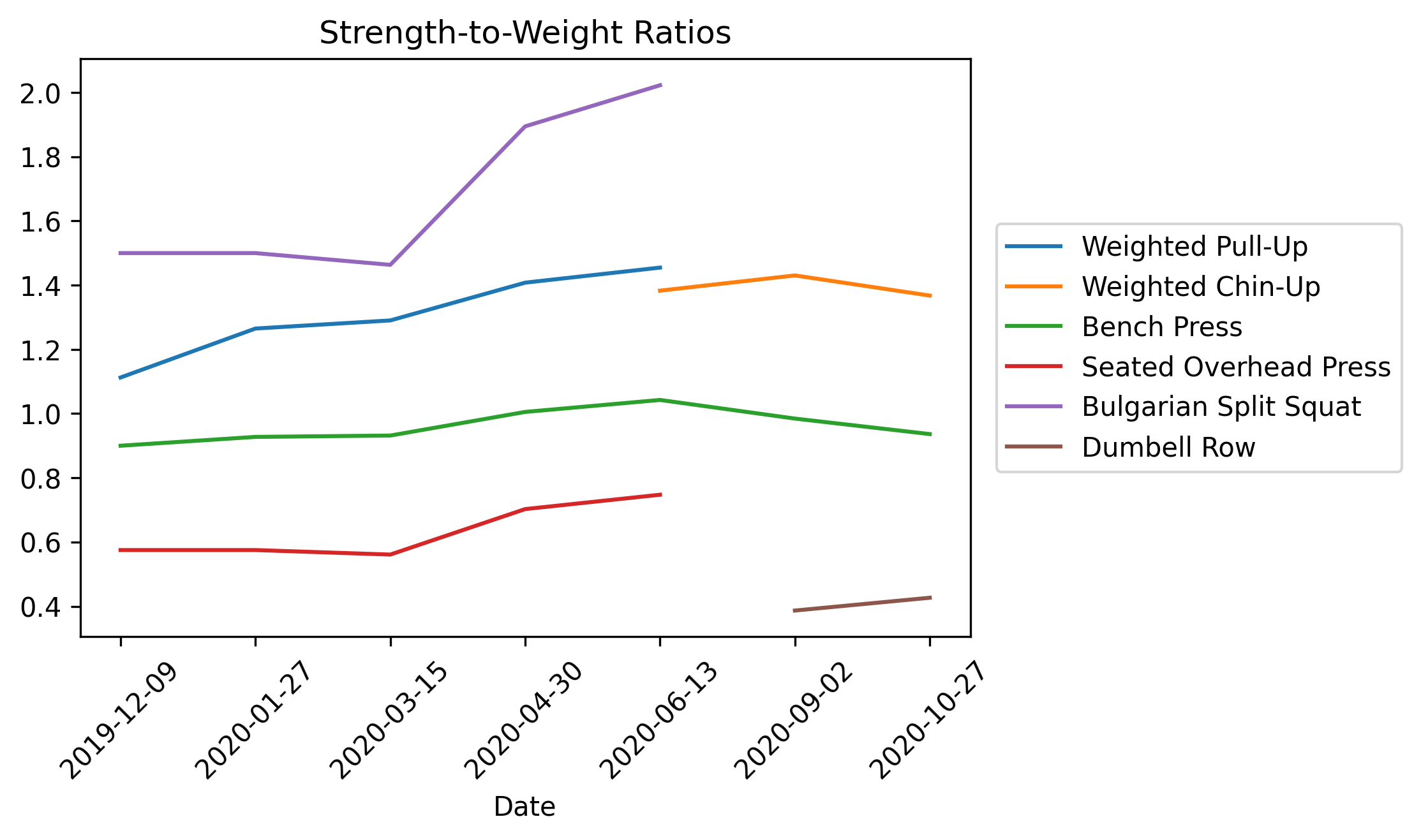
Update - 9/2/20
Latest graphs at the end of another 6-week Tactical Barbell cycle.
My bench press dropped a bit due to sustaining and recovering from a minor shoulder injury.
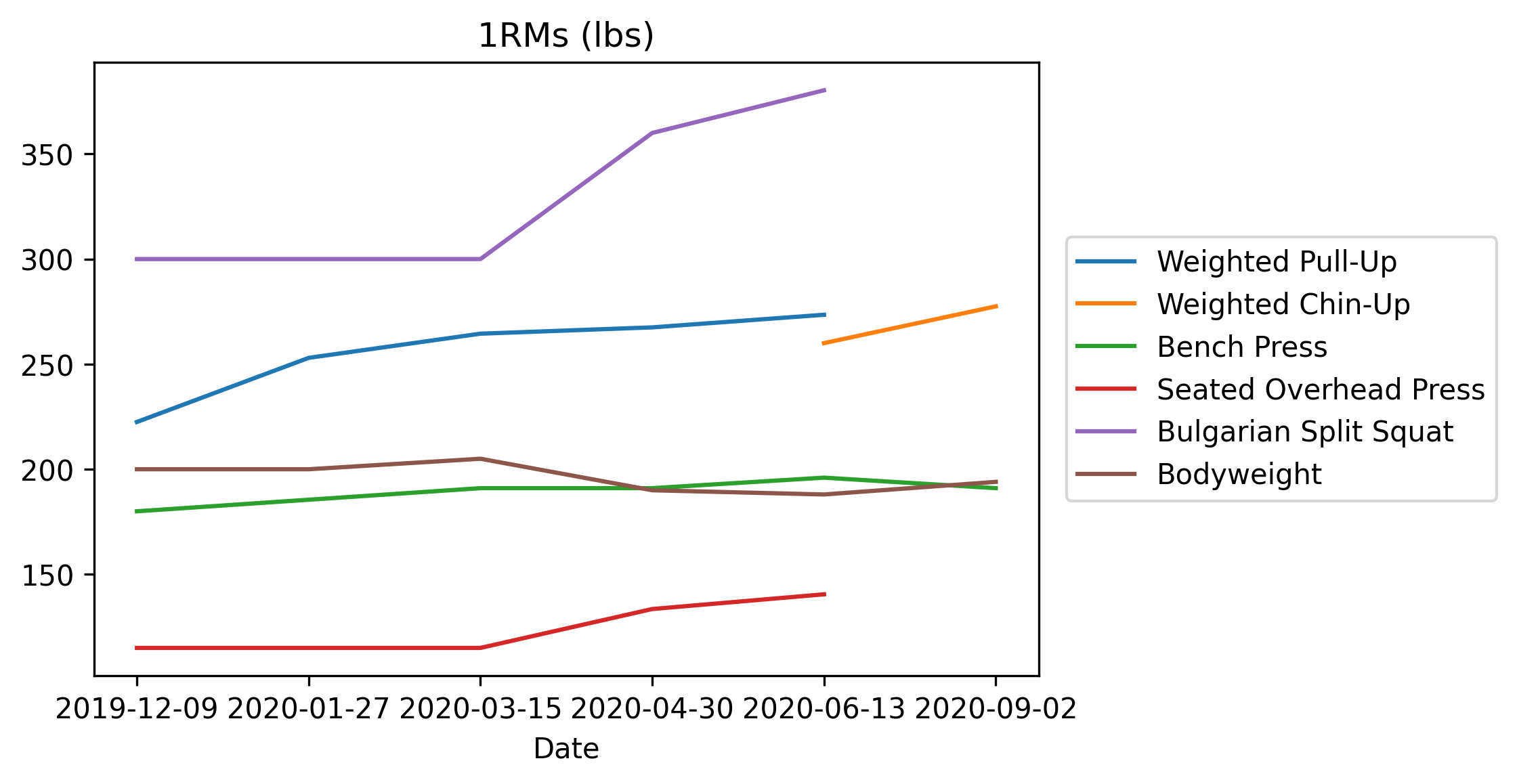
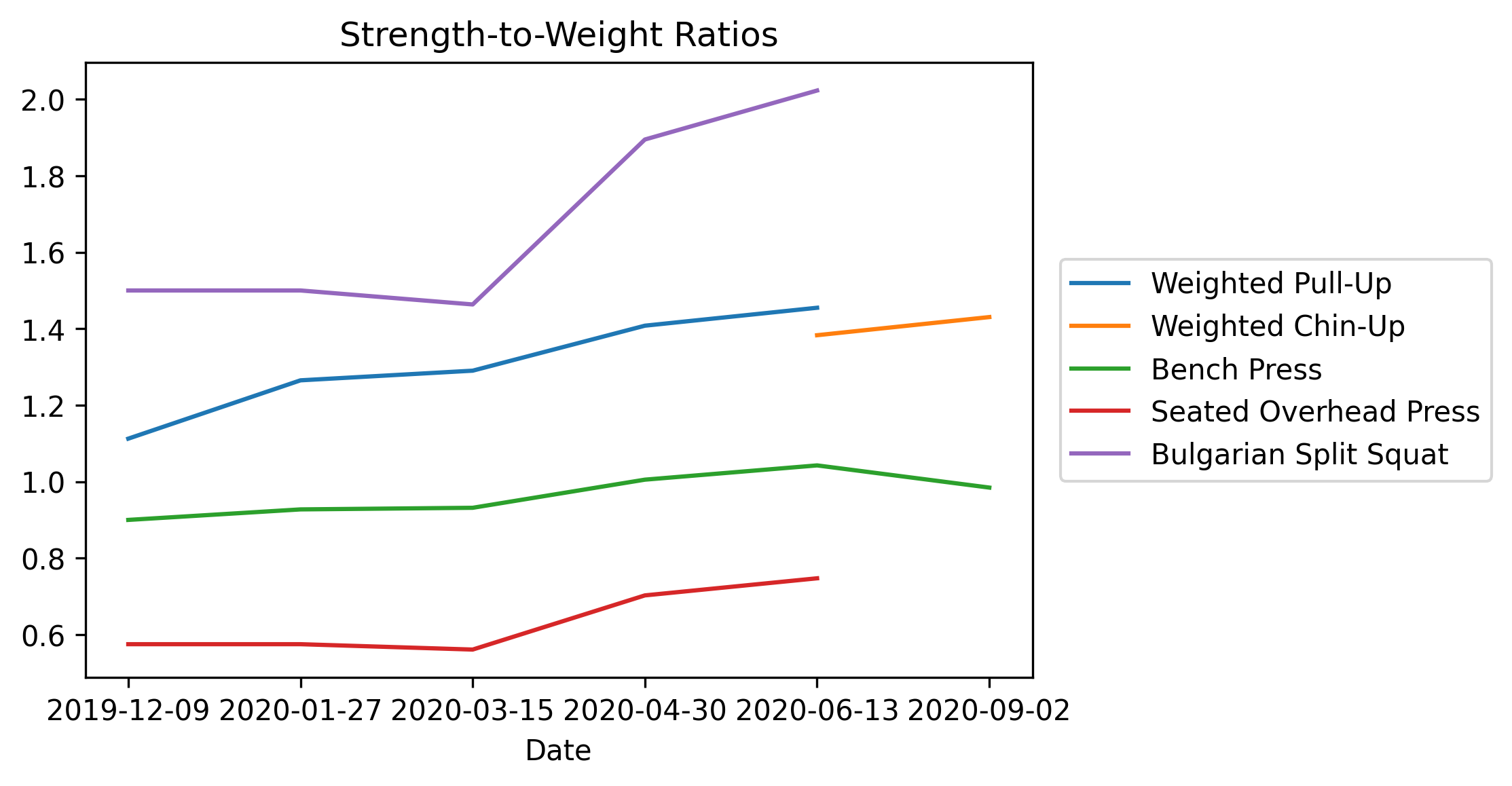
Update - 6/14/20
Latest graphs at the end of another 6-week Tactical Barbell cycle.

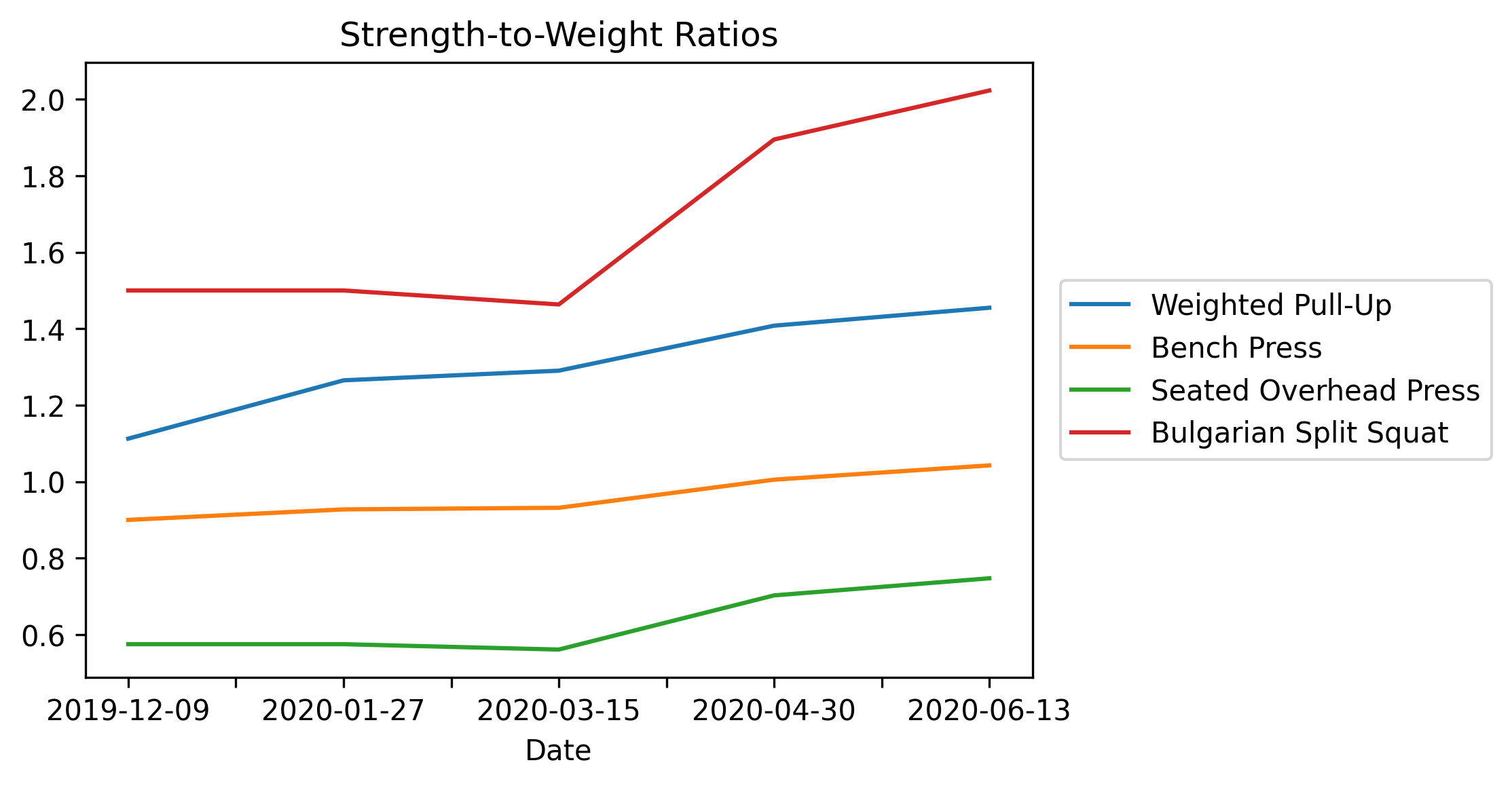
Where I began
As a child, I never really did any form of organized sports. Sure, I did some karate classes, and even participated in a t-ball league for a few months in… first grade?, but I have almost no memory of those times, and it wasn’t sustained enough to count.
My first real experience with athletics instead came from joining the cross-country and track teams during freshman and sophomore year of high school.
To be honest, I think my main reason for joining them was because that’s what the nerds did at my high school. Everyone knew that PE sucked, and for some reason or another, there was only one alternative for nerds: cross country in the fall, and track & field in the winter and spring. So that’s what my friends and I did.
I hated cross country. Running long distances was, and still is to me, an exercise in ever-increasing boredom and pain. I learned that I could do it, as in, I could physically move my body through space for the eight or nine miles of any given run, or the more intense but shorter 3 mile races, but I also learned that I didn’t enjoy it. Not by a long shot.
Track was better. You could choose your events! They had sprints! I primarily ran hurdles (I was tall) and the 400m. And unlike cross country, since everyone wasn’t competing simultaneously, you could actually go watch and cheer on your friends. Everything about this was fantastic.
Track also taught me some valuable, though somewhat tangential, skills: how to cheer really, really loudly; how to mentally cope with interval sprints; and that if you intentionally lie to your friends by calling out their split times a few seconds slower than they really are, you can get your friends to try harder and thereby set new PRs, and while they’ll thank you afterwards, they’ll also think you’re a maniac.
Once sophomore year was over, I had fulfilled my 2-year “PE” requirement, and I dropped the organized athletics entirely to focus on the more important math and science competitions in my life.
Throughout this period, I had only minimal exposure to strength training. I had seen the inside of a weight room before, and of course I had seen any manner of targeted weight machine, but I did not understand them, nor did I feel even remotely comfortable with them.
College years
Going into Caltech, I wanted to get back into athletics, and I had an growing interest in strength training.
Over the summer before my freshman year, I had picked up a copy of Arnold Schwarzenegger’s “The New Encyclopedia of Modern Bodybuilding” which was, by weight, 99% an encyclopedia of every exercise you can imagine, and 1% thoughts about how to structure them together as a coherent program. Nevertheless, once rotation was over and all the chaos of move-in and adjusting to the new world had settled down, I began to hit the weight room—and track, for more of those interval sprint workouts!—on an extremely irregular basis with a variety of friends over the years.
Notable memories include watching a post-doc I knew doing bench press with ~140lbs on the bar—he was using the big plates!—and visiting the much less-well air conditioned, much grittier, but much more viscerally enjoyable weight room at Los Alamos during the summer research fellowship I did there.
By far, though, the most major thing to happen to my athletic trajectory during my time at Caltech was about two weeks before I was supposed to move in early for pre-season track & field training (hurdles again!), when I was flipping through the course catalog and saw a listing for “table tennis”. Three thoughts passed through my head in quick succession: college is about trying new things, right?; I enjoy playing ping pong in my back yard…; and “you know… hurdles are kind of boring…”.
I switched over.
In pleasing symmetry, there were three important things that I didn’t realize at that point:
- I had accidentally signed up for the advanced section.
- The coach, Wei, used to play professionally in China, and played on the US Olympic squad after emigrating.
- Table tennis was a sport that many learned to play from a very young age, and most of those in the advanced section had been playing for years.
It was immediately obvious that I had no idea what I was doing.
After the first session, the coach came up to me and asked if I was sure I had signed up for the correct section, and explained that maybe I would be better off switching on one of the beginner/intermediate groups. Not to be deterred, I decided that instead of switching sections, I would simply attend all of the sections every week. This would prove to be one of the best ideas of my life.
Over the next four years, I became, though certainly not the best, one of the better players at Caltech, and built wonderful, and enduring, friendships with many people through the table tennis community. My lengthy discussions about technique with Wei easily taught me as much physics as several of the courses I was taking for my degree, and the stability and sleep-requirements of that training became a rock that I could lean on to ground and support myself through the harder trials of those years.
Notable memories include one exhausting day in San Diego when we decided to field three teams amongst a total of 6 people at a NCTTA tournament; getting to coach our Women’s team at nationals for two years in a row (first in Columbus, OH, and then in Rochester, MN); and traveling up to Stanford in 2007 to watch the World Junior Championships being hosted there.
2008-2010
The two years after I graduated were more tumultuous for me. I moved across the country twice before finally settling in Mountain View, I switched jobs several times, and finally ended up diving into the startup world while working on natural language processing applied to email database analysis.
During this time, I continued to play table tennis at whichever club was most convenient for wherever I was living, but the organized training I enjoyed while at Caltech was largely absent.
Meanwhile, I had no regular gym/weight room access, so that ended up on the back-burner.
2010-2016
Before moving up to Silicon Valley in 2010, I became more seriously interested in strength training, picked up a copy of the Starting Strength book, and a set of Ivanko weights and barbell off of someone on craigslist in Los Angeles. When I finally moved into a place with a garage, I built a squat rack and a bench—both wooden! I know!—and got to training. The bench was a beautiful piece that I still have and use as regular furniture. The squat rack was a wobbly, scary piece of kit with only two hook positions available (one for bench press and one for squats), but hey, at least it had safety rails. And it was cheap.
It was with that setup that I set a number of PRs. My working weight for three sets of five reps passed 250 lbs on squats, 150 lbs on bench press, 115 lbs for standing press, and 300 lbs on deadlift (ok, just for one set of five reps, not three sets on deadlift). During the later part of this period, I moved again, no longer had a garage, and joined Boss Barbell Club, where in that impressive company, I notably improved my working weight for squats up to my all-time PR of 275 lbs. You learn a new kind of respect for gravity when you pass the point of having more than your entire body weight on a barbell on your back, so I can only imagine the focus and dedication required of those athletes at BBBC whom I saw squatting 500, 600, and even 700+ lbs.
This time period also led to a renaissance in my table tennis training. If you’re familiar with table tennis in the US, you know that California is one of the hot spots. And if you’re familiar with table tennis in California, you know that the bay area, in particular, is Mecca.
If you’re not familiar with the scene, understand that in most areas of the US, and even elsewhere in the world, table tennis clubs are often share their facilities part-time with other groups, either as part of independent businesses, or as part of a community recreation center. Thus, while it’s not unheard of, it’s also not the most common thing to find a club with a dedicated space. Even once you find such a club, it’s rarer still that they will be set up and equipped with professional-grade flooring and lighting—things that make a significant difference for the quick, lateral movements of the sport, or when lobbing and smashing high balls.
The bay area is composed of many small cities, and each city has a dedicated club with professional flooring and lighting. Some cities have several. Opposite the situation elsewhere, it is rare here to find a club that only has a part-time facility, or one that subjects players to playing on wooden or tile flooring. Professional-grade equipment, dedicated facilities, and top-tier players are de rigueur.
For further comparison, in last US National Championships in 2019, every one of the four finalists in both the women’s and men’s singles came from a club in the bay area, and in fact, from a group of three clubs, all within a four-mile-radius circle on the map.
Playing table tennis here has been fantastic. After browsing between several clubs, I picked one and have been a regular at their trainings and league events (though I still drop in at other clubs, time permitting), and my technical understanding and ability with the game have continued to improve.
2016-2017
These years were challenging for me due to an incidence of back injury. On several occasions, I ended up tweaking my back to the point where I could not move out of bed the next day without excruciating pain. I reset my working weights for lifting back down to zero several times, and I had to take care to slowly reintroduce even the intensity of my table tennis training.
I struggled for a solution until I encountered the work of Stuart McGill, who I eventually ended up visiting in his home office in Canada. His life’s work is understanding the biomechanics of the back and torso, and working with individuals and athletes of every caliber (including many olympians and world record holders) to rehab and return to form after injuries.
His methods were magic. Not in the sense that he was able to speak a short incantation, wave his hands, and bam my problems were resolved, but in that unlike any of my prior consultations and appointments, he went into great depth to understand the specific issues I was facing, and his recommendations, like the McGill Big 3, when applied diligently, finally and completely resolved all of my problems.
After that, I also adjusted my strength training routines to accommodate my McGill-inspired focus on resiliency and stability: I traded barbell squats for Bulgarian split squats, and moved all of my deadlifting to sumo-style.
2018-2020
The last few years have seen, by far, the greatest progress in athletics of my life. This comes down to three things:
-
A change in my responsibilities with my job meant that I no longer had to travel to Florida one week out of every four. Hello improved consistency!
-
I changed strength training programs. After much searching, and some trial and error on my own, I settled into a routine following the progressive training templates in Tactical Barbell. The problem prior to this is that the energy demands of my lifting and table tennis training in parallel had grown to be too large, and so I would often find myself either tired at table tennis from my lifting the night before, or experiencing slower gains in lifting due to the long sessions of table tennis. The Tactical Barbell program is the best I’ve encountered yet for structuring strength training as a supplementary activity to your main sport, and has supported my progress in both, wonderfully.
-
The RP App. A close friend of mine went to work for that company, and recommended I try out their app. Now, I had done various forms of diet tracking before, following templates, and even building an eventually-surprisingly-exhaustive database of nutrition facts for Trader Joe’s products, I had only really had relatively middling success. I often had difficulty maintaining the trajectories of my bulk or cut diets, and attempting cut diets, especially, was always miserable.
Enter RP. Like you might expect, to use the RP diet app, you have to tell it what kind of a diet you want to do (muscle-building, maintenance, or fat-loss), and some basic things about yourself and your schedule (height, weight, daily wake-up & sleep times, and workout timing and duration). What you—and I, certainly!—might not expect is that not only will it tell you how much protein, carbs, and fat to eat each day, but it will also tell you when to eat it. Things like “1:15pm - 30g protein, 15g fat, 20g carbs”. This makes a huge difference. By getting your individual meal timing and sizing right, you can optimize for your individual metabolism, and, when on a fat-loss diet for example, can give your body the regularly-spaced doses of protein it needs to maintain muscle mass, while still being in a caloric deficit to encourage fat loss.
Bonus points to the RP app for also giving you an easy way to select what you’re about to eat from a whole range of different foods, cooking styles, and even by scanning barcodes, and then automatically calculating what total weight of foods you should consume to hit your target macros.
So that brings us to roughly today, and the events of my Quarantine Projects.
Finally, I’ll end with some progress graphs from my use of the Tactical Barbell routine:
